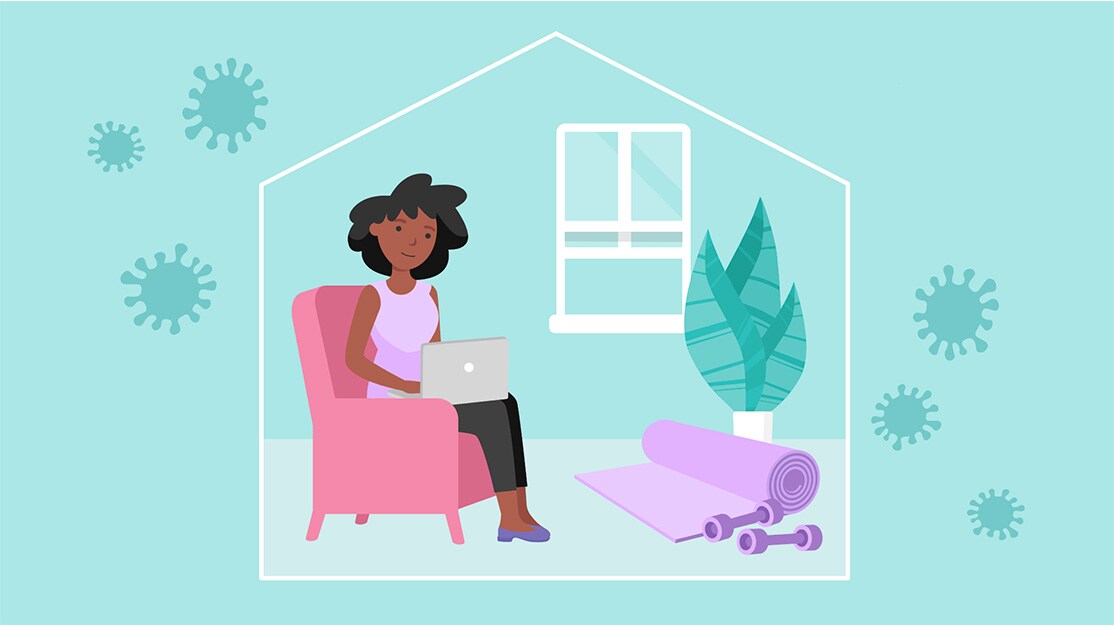Tips for staying active and eating well during COVID-19
Clinically reviewed by Jen Matz, MPH

You may have seen jokes about the dreaded "quarantine 15"—gaining an inevitable 15 pounds during shelter-in-place due to coronavirus disease 2019 (COVID-19).
But the truth is, this doesn't have to happen. Despite being inside and despite the constant stressors of this different way of living, we can take charge of whether or not we move and how we eat.
Get moving
Any exercise is better than none. Yet, navigating lifestyle changes during the pandemic can make finding the motivation to get moving a real challenge. A trick to success is determining the reasons we're not exercising—and then finding ways to overcome those reasons with motivation.
What's keeping you from moving?
I have no time.
- Plan. Identify timeslots in your schedule when you can be active. Try to achieve 30 minutes of activity, 5 days per week. If you don't have 30 minutes of continuous time, consider breaking the activity into three 10-minute sessions.
- Power-up. Add more activity to your normal routine: Take the dog for a long walk every morning. Make lunchbreak a power-walk break. Have a dance party when the kids finish their schoolwork.
- Pause. Set regular reminders to take mini breaks from work or home activities. If you stand at work, stretch. If you sit at a computer, get up. Paying attention to your physical self does a body good.
I have no energy.
- Recognize the irony. Regular exercise can help your cardiovascular system work more efficiently and help you feel energized. The trick is taking that first step.
- Mind over matter. Remember the last time you exercised? Remember how good it felt? Convince yourself to get up for that same reward. This is hard—but it's not impossible.
- Remember your goals. Do you want more energy to play with your kids? To fit into your shorts? To combat a health issue? Write down your goal, look at it every day, and make that your purpose.
I have no skills.
- Be humble. Learning a new activity is good for the body, mind and spirit. Everything from chair exercises to weight training is available online.
- Choose something you enjoy. Don't overthink it – you don't need fancy equipment or a rigorous routine to get a good workout. Go for a walk, take a bike ride or play tennis with a family member. Choose an activity you enjoy so you stick with it for the long haul.
- Be safe. Always check with your health care provider before increasing your activity level. Choose activities that are appropriate for your age, fitness level, skill level and health status. And opt for exercise that involves minimal risk for you.
- Get support. Reach out to a friend or family member and share your goals. Ask them to participate in a program with you. Or see if they can be your check-in buddy for accountability and applause.
Eat mindfully
Nothing goes better with a TV series than a pint of ice cream. But the truth is that poor eating habits will catch up to our health—and our waistlines. So, what's a media-proficient snack connoisseur going to do? Here are nine ideas to help us eat healthier and more mindfully.
9 tips to eat better:
- Log food. Track what you eat every day, including snacks and bites, which can add up in calories. Pay attention to macronutrients—carbohydrates, fats, and proteins—for a comprehensive view of your diet, and what you can adjust to be more balanced. (Several apps can help with this.)
- Snack mindfully. Before reaching for a snack, ask yourself if you're bored, tired, thirsty or hungry. If your stomach wins the bet, opt for small portions of nutrient-dense snacks, such as an apple with a smear of nut butter or raw vegetables and hummus.
- Screen yourself. Avoid eating meals and snacks in front of the TV, computer and phone. Distractions can lead to unintentional overeating.
- Plan ahead. Write down a list of foods you're going to eat the next day. Prepare ingredients or meals themselves to help from veering off plan.
- Get creative. With fewer trips to the grocery as we stay home, spice things up with different stir-fries, smoothies, and salad combinations to get more bang for your nutritious (and financial) buck.
- Avoid liquid calories. Soda, juice, energy drinks, and alcohol rack up empty calories that can lead to weight gain.
- Plate first. Practice portion control so you don't overeat. For each meal, be sure to get: 3—4 oz. of lean protein, such as chicken breast or fish, fill half of your plate with fruits and vegetables, and make sure half of your grains are whole grains, such as brown rice, barley or oats.
- Hydrate. Be sure to drink plenty of liquids each day to stay hydrated. While each person's specific fluid needs vary, women need about nine cups of fluids and men need about 13 cups of fluids each day. This amount can come from water, other beverages and foods. If drinking enough water is a challenge, add lemon, mint or cucumbers for a bit of flavor.
- Read labels. Know what you're putting into your body. In general, avoid processed foods and choose whole foods instead. Try to stay away from foods high in added sugars, saturated and trans fats and sodium.
Know that you're not destined to gain the "quarantine 15." You can be physically active, make nutritious food choices and ward off weight gain while social distancing. A healthier you is always worth the extra effort.
(Please consult your health care provider before starting a new exercise or diet program.)
Published on June 4, 2020
Sources:
https://www.mayoclinic.org/healthy-lifestyle/weight-loss/in-depth/weight-loss/art-20047342
https://www.health.harvard.edu/diet-and-weight-loss/struggling-with-emotional-eating
https://www.cdc.gov/physicalactivity/basics/adding-pa/barriers.html
https://www.choosemyplate.gov/WhatIsMyPlate
https://www.mayoclinic.org/healthy-lifestyle/fitness/in-depth/exercise/art-20048389